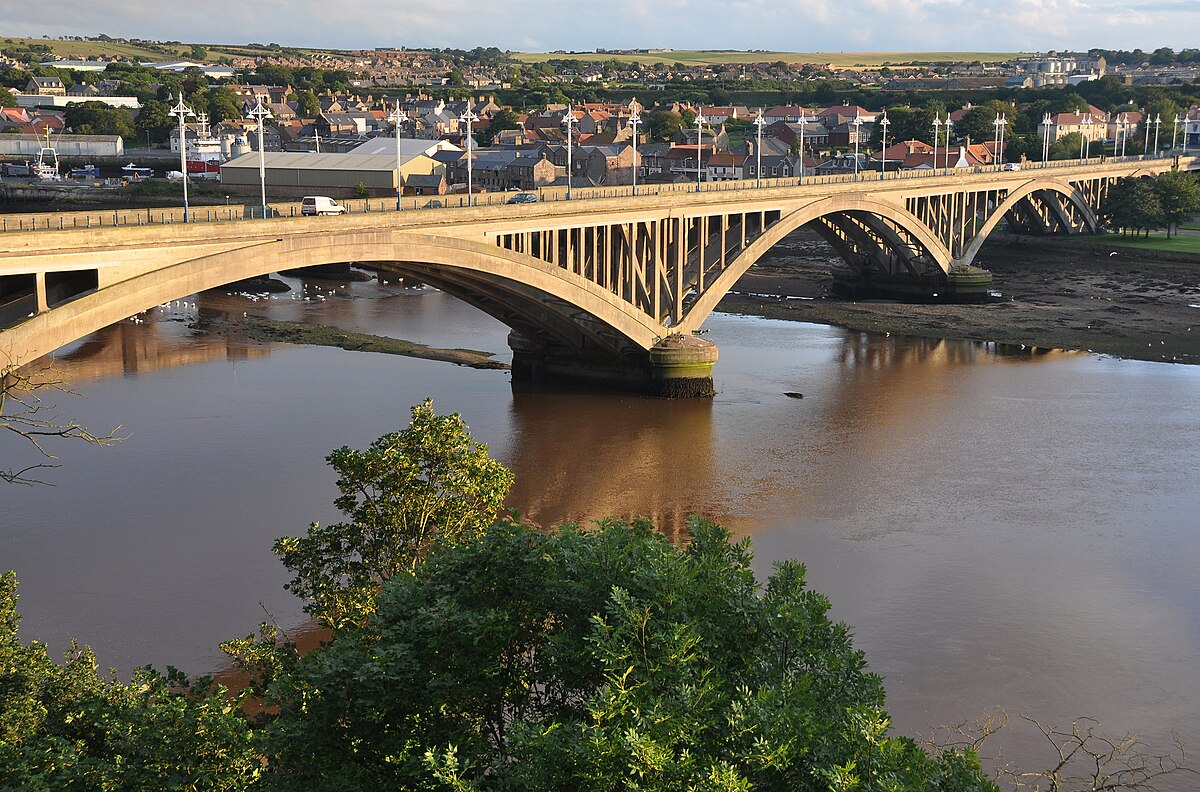The Royal Tweed Bridge is a significant and modern road bridge spanning the River Tweed at Berwick-upon-Tweed in Northumberland, England. Constructed in the mid-20th century, it was designed to accommodate the increasing demands of motor vehicle traffic and to complement the historic Berwick Bridge and the Royal Border Bridge.
Historical Context and Construction
Background:
- Traffic Needs: By the mid-20th century, the existing Berwick Bridge (also known as the Old Bridge) and the Royal Border Bridge were insufficient to handle the growing volume of road traffic. The increase in vehicle numbers necessitated the construction of a new, modern bridge.
- Planning: Plans for the Royal Tweed Bridge began in the early 20th century, with the aim of providing a more efficient route for road traffic while preserving the historical and architectural integrity of the older bridges.
Construction:
- Timeline: Construction of the Royal Tweed Bridge started in 1925 and was completed in 1928.
- Engineering: The bridge was designed by L.G. Mouchel and Partners, a firm known for its expertise in reinforced concrete construction. The use of reinforced concrete was relatively innovative at the time, allowing for a strong yet aesthetically pleasing structure.
Structural Features
Design:
- Arch Bridge: The Royal Tweed Bridge is an arch bridge, featuring two main arches that support the roadway. This design not only provides the necessary strength to support heavy traffic but also harmonizes with the aesthetic of the nearby historic bridges.
- Length and Height: The bridge spans approximately 197 meters (646 feet) across the River Tweed. It has a height of 30 meters (98 feet) above the river, ensuring sufficient clearance for river traffic.
Construction Materials:
- Reinforced Concrete: The use of reinforced concrete was a modern choice, providing durability and strength. This material choice also allowed for the sleek, curved lines of the arches, contributing to the bridge’s elegant appearance.
Function and Usage
Traffic Flow:
- Road Traffic: The Royal Tweed Bridge was designed to accommodate modern vehicular traffic, providing a vital link for road transport between England and Scotland. It significantly eased congestion on the older Berwick Bridge, which was more suited to pedestrian and light vehicle traffic.
- Pedestrian Access: While primarily a road bridge, the Royal Tweed Bridge also includes provisions for pedestrian access, ensuring that it serves all members of the community.
Economic Impact:
- Commerce and Trade: By improving road connectivity, the bridge has played a crucial role in facilitating commerce and trade in the region. It has helped bolster the local economy by providing a more efficient route for goods and services.
- Tourism: The bridge itself, along with the picturesque views it offers of the River Tweed and the surrounding historic town of Berwick-upon-Tweed, attracts tourists and enhances the town’s appeal as a destination.
Aesthetic and Cultural Significance
Architectural Harmony:
- Blending Old and New: The design of the Royal Tweed Bridge complements the nearby historic structures. Its elegant arches and modern materials create a visual harmony with the Berwick Bridge and the Royal Border Bridge, reflecting the town’s blend of historical heritage and modern development.
Landmark Status:
- Cultural Icon: Over time, the Royal Tweed Bridge has become a cultural icon in its own right. It symbolizes the evolution of engineering and transportation in the region, marking the transition from historical to contemporary infrastructure.
- Photographic Appeal: The bridge is frequently photographed by tourists and locals, capturing its architectural beauty and the stunning natural landscape of the River Tweed.
Maintenance and Preservation
Ongoing Upkeep:
- Structural Maintenance: Regular inspections and maintenance work are carried out to ensure the bridge’s safety and longevity. This includes monitoring the integrity of the reinforced concrete and addressing any wear and tear resulting from heavy traffic and environmental factors.
- Preservation Efforts: As a significant piece of infrastructure, the Royal Tweed Bridge is subject to preservation efforts to maintain its structural health and aesthetic appeal. These efforts ensure that it continues to serve the community effectively.
Conclusion
The Royal Tweed Bridge stands as a vital piece of infrastructure and a symbol of modern engineering in Berwick-upon-Tweed. Its construction in the early 20th century marked a significant advancement in road transport, addressing the needs of a growing volume of vehicular traffic while complementing the historic bridges nearby. The bridge not only facilitates efficient movement and economic activity but also enhances the town’s cultural and aesthetic landscape. As a testament to innovation and progress, the Royal Tweed Bridge remains an essential and cherished landmark in the region.



